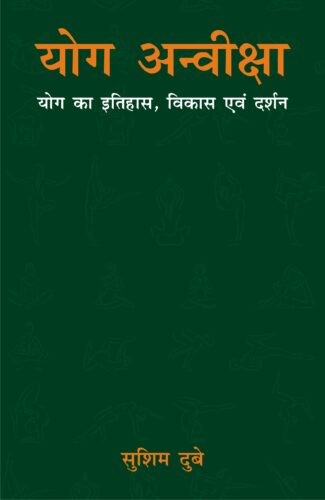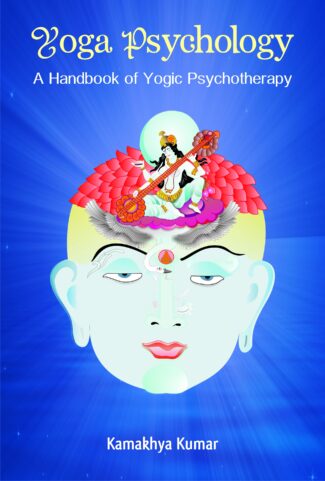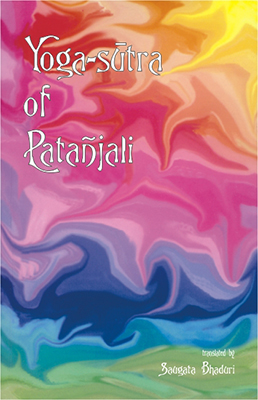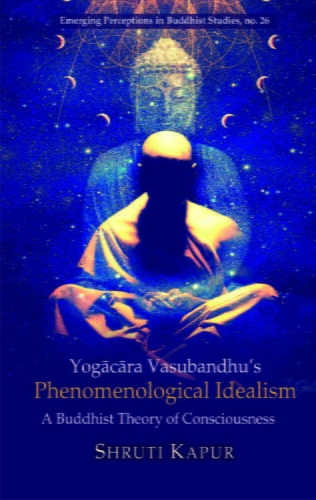Showing 1041–1050 of 1063 results

The book, highlights the essential import of the innocuous-looking, yet enigmatic, diagrams called Yantras surfacing from the occult practices of the tantrics. It examines a range of tantric yantras, with their varieties, applications, modes of construction and above all their iconographic features.
Hinduism is known for the bewildering profusion of its deities, who are represented not only in two or three dimensional anthropomorphic images, but also in abstract configurations, known as yantras. In yantras is, thus, seen almost a parallel with the surfeit of deities in Hindu tradition. Literally meaning an instrument, apparatus or a talisman, yantra is a kind of mystical diagram used, in tantra, for both meditation and invoking a divinity, and is believed to possess/arouse occult powers. Drawn only by the adept: the ones schooled in this arcane, highly intricate process, and energized by siddh mantras, these seemingly innocuous geometrical figures are employed for any number of reasons or desires: whether to attain wealth, ward off disease, beget a son, vanquish enemies, or even to cause somebodys death. This book, the latest from Professor Bunce, highlights the essential import of these innocuous-looking, yet enigmatic, diagrams surfacing from the occult Practices of the tantrics. The author, an internationally known scholar of Oriental Art, examines a range of tantric yantras, with their varieties, applications, modes of construction and, above all, their iconographic features. Also inter- woven in his text are lucid descriptions of all else associated with a yantra, notably, its deity, its specific purpose, its predominant and secondary numbers and its mantra. Carrying beautiful visual representations of over a hundred yantras, Professor Bunces study holds out enduring appeal to the readers concerned not only with the iconography of tantric yantras, but their mystifying under-pinnings as well.

It is an authentic edition and consistent documentation of the complete philosophical journey of Shri Yashdeva Shalya. It provides a penetrating philosophical reflection on the self-conscious act of self-conscious being engaged in the cultivation of culture and civilization through different modes of creativity.
Yashdeva Shalya Samagra is an authentic edition and consistent documentation of the complete philosophical journey of Shri Yashdeva Shalya. It is Yashdeva Shalya who can be considered as one of the most original thinkers of twentieth-century India, after the advent of Sri Aurobindo. The philosophical contributions of Yashdeva Shalya have taken the shape of a complete system of philosophy during his active engagement with the East and West history of ideas for the last five decades. It is widely known as the philosophy of Chidadvaitavada which truly depicts the metaphysics of human creativity. For Yashdeva Shalya, all modes of human creativity vis-à-vis philosophy, religion, history, culture, literature, ethics, aesthetics and scientific temper are nothing but an unending quest of self-conscious being in the direction of getting rid of its self-alienation. Thus, four volumes of Yashdeva Shalya Samagra, i. e. Jnana aur Sat, Cit aur Mulya, Samaj aur Sanskriti and Darshnik Itihas-Dristi provide a penetrating philosophical reflection on the self-conscious act of self-conscious being engaged in the cultivation of culture and civilization through different modes of creativity. The collection of these four volumes will be certainly a valuable asset for the library of any institution and for sincere knowledge seekers.

???? ?????
???????? ???? ??? ??? ?? ??????, ????? ??? ????? ?? ?????????? ?? ?????????? ?????? ?????????? ???? ?? ??????? ???? ??? ???
??????? ?????? ?????????? ??????? ?? ????? ?????? ??? ??????? ?????? ?? ?? ??? ?????? ?? ??????-??????? ??, ?? ????-????, ????????? ??? ???????? ????? ?? ??????? ??? ?????? ??????? ?????? ??, ??? ??? ??? ?? ??????? ????? ?? ?? ?? ????? ?????????? ??? ?? ?????????? ?? ???? ?? ???????????? ?? ??? ?? ????????? ??? ?????? ?? ??? ?????? ??? ?????????? ???????????? ?? ??? ?? ????????? ?? ???????????, ?????, ?????? ??? ?? ?????? ?? ???????? ???
???????? ?????? ???-??? ???????? ?? ????? ???????? ?? ??????? ??? ?????? ??? ???????? ?? ????? ??, ???????? ??? ??, ??????? ???????? ?? ??? ?? ???????? ??? ??? ???? ??? ??????? ??? ?????? ?? ?? ??????? ???? ??? ??? ?? ???????? ???????? ????????? ?? ??? ?????????? ????? ??? ???????? ?? ???????? ????, ???? ??? ?????? ??? ?????????? ?? ?????, ??? ?? ???????? ?? ??? ????? ???? ????? ??? ???? ?? ???????? ??? ????? ?????? ?? ??? ??? ?? ?? ????????? ?? ???? ???? ????
?? ?????? ??? ???×?? ???, ?????, ?????????, ?????, ??????????, ????????, ??????? ??? ???????? ?? ????????? ?????? ???? ??? ??? ???×?? ??? ??????? ?? ????????? ??? ?????????? ?? ?????? ??? ???-???????? ???????? ?? ???? ??? ????? ????? ???????? ??? ??? ??????? ???? ????????, ??- ??????????? ??? ??? ????? ??????? ?? ????? ?? ?????? ????? ?????? ?????????? ???? ??? ??????? ??? ??? ??? ?? ????????? ????? ??? ??????, ?????? ?????????, ????????? ??? ?????? ?? ????? ?? ????? ????? ???? ??? ??? ??????? ?? ?????? ??? ?? ???????????? ????? ???? ??, ?? ??????????? ?? ??????? ???? ??? ??????? ??? ??? ?? ??? ?? ????? ???? ???? ??? ??? ?? ???? ?????? ???? ??? ??? ???? ??? ??????? ??????????? ?? ????? ???? ????????????? ?? ????? ???? ??? ???
?? ??? ??? ????? ?? ??????? ??? ????????? ????? ?? ?????????? ???, ?? ????? ?? ???, ??? ????????? ???? ?????? ?? ??????? ???
“कृति परिचय
प्रस्तुत कृति में योग के इतिहास, विकास एवं दर्शन को जिज्ञासुओं के समाधानार्थ सरलतया प्रतिपादित करने का परिश्रम किया गया है।
फ्योगय् भारतीय सांस्कृतिक परम्परा की अनमोल विरासत है। सहड्डों वर्षों के तप एवं अभ्यास से ऋषियों-मुनियों ने, जो शरीर-रचना, स्वास्थ्य तथा अध्यात्म साधना की सामूहिक एवं एकीकृत प्रणाली विकसित की, वही योग है। यह फ्योगय् इसलिए भी है कि इसमें फ्जुड़नाय् है। इस फ्जुड़नेय् को शरीर के परिप्रेक्ष्य से लें तो स्वास्थ्य एवं आरोग्य के साथ जुड़ना है। आध्यात्मिक परिप्रेक्ष्य से लें तो आत्मज्ञान या ब्रह्मज्ञान, मोक्ष, कैवल्य आदि से जुड़ना या प्राप्ति है।
प्रस्तुत ग्रन्थ योग-परक अन्वेषणा की अनवरत जिज्ञासा का प्रतिफल है। वास्तव में जिज्ञासा ही मुख्य है, प्राप्ति गौण है, क्योंकि जिज्ञासा का शमन ही प्राप्ति है। योग जीवन में पूर्णता एवं सन्तोष की एक अनुभूति भरता है। योग की वास्तविक प्राप्ति व्यत्तिफ़ को सतत ऊर्ध्वगामी बनाती है। लक्ष्यों की प्राप्ति सुगम, जीवन में समरसता एवं सामंजस्यता का दिऽना, योग के प्रतिफलन के कुछ संकेत हैं। साध्य एवं साधन की अनुकूलता एवं उनमें शुचिता का बोध योग पथ पर व्यत्तिफ़ को दृढ़ रऽते हैं।
इस ग्रन्थ में पात×जल योग, हठयोग, मन्त्रयोग, लययोग, भत्तिफ़योग, ध्यानयोग, कर्मयोग तथा ज्ञानयोग का प्रामाणिक विवेचन किया गया है। पात×जल योग परम्परा के टीकाकारों एवं भाष्यकारों का विवेचन तथा योग-सम्बन्धी उपनिषदों के विषय में कतिपय विवरण प्रस्तुत हुआ है। समकालीन योगी योगानन्द, जे- कृष्णमूर्ति एवं ओशो रजनीश प्रभृति के दर्शन का सारभूत परिचय सरलतया प्रतिपादित किया है। वर्तमान युग में योग की स्वास्थ्य रक्षण में भूमिका, मानसिक स्वास्थ्य, सन्तुष्टि एवं शान्ति का मार्ग भी इसमें सिद्ध किया है। योग नैतिकता की शिक्षा में भी महत्त्वपूर्ण स्थान रऽता है, यह युत्तिफ़यों से सुसिद्ध किया है। उपनिषद् आदि में भी योग के विविध आयाम सुलभ हैं जिन पर रोचक प्रकाश डाला गया है। अन्त में संस्कृत मूलग्रन्थों की सूचना देकर विद्यार्थियों को उपकृत किया गया है।
हम सभी योग ऊर्जा से समन्वित एवं सात्त्विक गुणों से परिपूर्णित हों, इस भावना के साथ, योग अन्वीक्षा सुधी पाठकों को समर्पित है।”

Dr. N. C. Panda examines yoga-nidra as a scientific discipline the theory, its psychological basis, its techniques and applications to reveal its significance as a means of strengthening the bodys immune system and preventing and curing diseases and regulating ones life patterns. It involves comparative analyses like that of yogic trance and hypnotic trance and yoga-vedanta and Freudian psychologies.
Healing of body and mind through yoga is gaining immense significance at present as a world-wide science of therapy. In this context, yoga-nidra, a self-therapy technique of yoga and tantra, is important as an effective means of regulating the mind. In this volume, Dr. Panda, a noted philosopher and psychologist, yogi and tantrist, delves into the principles and practices of yoga-nidra based on materials from the tantras and Patanjali Yoga in an attempt to explain its benefits with special reference to modern medicine. The book presents yoga-nidra as a scientific discipline that is a potent means to strengthen the bodys immune system and thus to prevent and cure diseases and to regulate ones life patterns. It examines in detail the theory of yoga-nidra, going into the Indian concept of mind and personality. It establishes the psychological basis of yoga-nidra by comparing hypnotic trance and yogic trance and Freudian and Yoga-Vedanta psychologies. It then lucidly presents the techniques of yoga-nidra and deals with the applications of yoga-nidra with relation to curing of psychosomatic and other diseases of common occurrence and to solving current problems such as drug-addiction and stress-induced maladies. This well-conceived and thorough research work will prove useful to scholars of ancient Indian medical science and psychology, particularly those concerned with study of yoga vis-a-vis modern medical problems and systems. It will be of equal importance for the general readers owing to its interesting subject matter, simple style of presentation and easy adoption by the non-adepts.

In the present time, yoga has attracted all kinds of professionals and got its alliance in almost all subjects. Study of yoga has been prominent in the curricula of Sanskrit studies, from which it evolved traditionally, but it has of late found relevance in other disciplines like Philosophy, Psycho-logy, Sociology, Music, Physical Education and Sports, Physiology, Medical Science, Bio-chemistry, Life Sciences, and Language and Literature. There are exclusive departments of yoga in various universities. The present book helps to address the yoga needs of people from all walks of life and presents the Yogic view from its origin and development to the needs of a modern, technocratic society.
With the observance of Yogic practices, the Indian spiritual gurus kept their body healthy and tuned, and elevated their mind to higher realms, which were essential requirements for their spiritual growth, for happiness and harmony in life. This ancient science found easy acceptance in foreign countries too. With the UNESCO coming into picture, yoga shot into limelight around the world. Apart from spirituality, other reasons for the revival of yoga as a lifestyle were its simple, light exercises which rejuvenate the mind and body, its no-harmful effects, and its power to inculcate superior values in life. Yoga has an edge over other health exercises like aerobics and weight lifting. Fitness of body and mind, work performance, psycho-physical balance and the overall well-being are easily attainable through the regular practice of yoga. The present book will be useful to a common reader and a seeker of yoga alike in knowing about its philosophy and will help them practise it in a simple, lucid way.
In the present time, yoga has attracted all kinds of professionals and got its alliance in almost all subjects. Study of yoga has been prominent in the curricula of Sanskrit studies, from which it evolved traditionally, but it has of late found relevance in other disciplines like Philosophy, Psycho-logy, Sociology, Music, Physical Education and Sports, Physiology, Medical Science, Bio-chemistry, Life Sciences, and Language and Literature. There are exclusive departments of yoga in various universities. The present book helps to address the yoga needs of people from all walks of life and presents the Yogic view from its origin and development to the needs of a modern, technocratic society.
With the observance of Yogic practices, the Indian spiritual gurus kept their body healthy and tuned, and elevated their mind to higher realms, which were essential requirements for their spiritual growth, for happiness and harmony in life. This ancient science found easy acceptance in foreign countries too. With the UNESCO coming into picture, yoga shot into limelight around the world. Apart from spirituality, other reasons for the revival of yoga as a lifestyle were its simple, light exercises which rejuvenate the mind and body, its no-harmful effects, and its power to inculcate superior values in life. Yoga has an edge over other health exercises like aerobics and weight lifting. Fitness of body and mind, work performance, psycho-physical balance and the overall well-being are easily attainable through the regular practice of yoga. The present book will be useful to a common reader and a seeker of yoga alike in knowing about its philosophy and will help them practise it in a simple, lucid way.

The sound practice of yoga enables one to have a disease-free body and keen intellect. This book details the impact of various yoga practices on psychology and specifies that consciousness has a wider conation in yoga in developing one’s personality traits and leveraging them further to keep him/her happy and experience a blissful life.
Yoga psychology is both a positive and a normative science. It not only analyses human personality and its growth, but sets normative ideals and prescribes techniques to achieve such objectives, as well. Thus, expansion of consciousness and making oneself the master of his/her mind are the broad objectives of yoga psychology. The topological aspect of mind as described by Freud in terms of conscious, subconscious and unconscious levels was well detailed in the yogic literature, thousands of years ago. The sound practice of yoga enables one to have a disease-free body and keen intellect.
The book, thus, details the impact of various yoga practices on psychology and specifies that consciousness has a wider conation in yoga. Yoga presents vivid and sound meditation procedures for the attainment of psychic consciousness through the awakening of kundalini. Homeostasis or balance is the central principle in yoga psychology, and it holds that any sort of imbalance in the system physical, psychological or pranic creates disorders and the solution lies in rebalancing it. Here comes the role of yogic psychotherapies such as prarthana, mantra sadhana, spiritual couselling, pranayama, yajna, sankirtana, svadhyaya and vrata anushthana.
This volume enunciates that yoga psychology is an applied science, and thus has remedies for many individual and social problems. It deals at large with the application and benefits of yogic practices in developing ones personality traits and leveraging them further to keep him/her happy and experience a blissful life.

The English translation of Yoga-sutra adopts a unique approach: it retains many Sanskrit technical terms to present their inadequate rendering in English and avoids elaborate commentaries. It examines Yoga philosophy in relation to other orthodox philosophical system and analyses issues of cognition and signification.
Patanjali’s Yoga-sutra, one of the most well-known works in the Indian classical tradition, is recognised as the primary text of Yoga philosophy. Here, Dr. Bhaduri adopts a simple but unique approach in his study of the text to make it more suitable to the needs of the Indian students. This English translation of the Yoga-sutra by Dr. Bhaduri under the guidance of Prof. Kapil Kapoor in shastra Group of Centre of Liguistic and English, at Jawaharlal Nehru University, retains many Sanskrit terms, adding the English equivalents in footnotes and the glossary to avoid making inadequate renderings of Sanskrit technical terms. It translates only what is stated in the concerned sutras without elaborate commentaries in order not to confuse the reader and to allow him to draw independent conclusions. Presenting the sutras in original Sanskrit form along with their Roman transcription, it examines the Yoga philosophy in relation to the other five orthodox systems of classical Indian philosophy and analyses the manner in which it deals with issues of cognition and signification.

Dr. T. N. Mishra explores the moral and philosophical meanings and significance of yoga and studies the philosophies and practices that bear reference to it. Abounding in illustration, notes and references to scholarly treatises, it explains yoga psychology, its classification, techniques and stages and practice and concentrating on Yoga-tantra and its impact on Indian art and architecture.
The word yoga and the various concepts associated with it are being interpreted and understood with great interest the world over especially in recent years. This work by a noted research scholar, Dr. T. N. Mishra explores the meanings of the word yoga and its moral and philosophical annotations, and conducts an intensive study of the philosophies and practices that bear reference to it. A thorough research, Yoga-Tantra and Sensuousness in Art goes into the theoretical foundations of Yoga, tracing its roots to the sacred scriptures and explaining the goal of Yoga, the discipline it involves, Yoga psychology, its techniques and stages, and classification and practice of Yoga as Mantra-Yoga, Laya-Yoga, Hatha-Yoga and Raja-Yoga. It comprehensively examines the aim and philosophy of Yoga-Tantra and the way to awaken the kundalini through the cakras practising Yoga-Tantra. It makes a detailed analysis of the Yoga-sadhana of the Natha siddhas (the ulta-sadhana) and Yoga-sadhana as found in Vaisnava and Buddhist Sahajiya. Citing interesting examples, it importantly deals with Yoga and Tantra as reflected in Indian art: the impact of the philosophy of Yoga-Tantra with its subtle sensuality on Indian secular and religious architecture and sculpture. Abounding in illustrations and extensive in notes and references to ancient scholarly treatises and exponents of Yoga and to modern researches on the subject, the book will interest all scholars of Indian art, philosophy and spirituality and appeal to general readers on Yoga as well.

This book is a comparative study of the phenomenology of Yogacara Vasubandhu and that of the German philosopher Edmund Husserl having the focus on the understanding of the deeply inner nature of consciousness or mind. It asserts that the Yogacara philosophy is much richer and comprehensive than the Western phenomenology, particularly the Husserlian phenomenology.
This book is a comparative study of the phenomenology of Yogacara Vasubandhu and that of the German philosopher Edmund Husserl having the focus on the understanding of the deeply inner nature of consciousness or mind. It articulates that the Yogacara philosophy is much richer and comprehensive than the Western phenomenology, particularly the Husserlian phenomenology.
Later Vasubandhu’s philosophical orientation was idealist in Indian sense or a phenomenologist in Husserlian sense. His Mahayana Yogacara idealism is based on Asanga’s seminal text Sandhinirmocanasutra and his own Vijnaptimatratasiddhi (Vimsatika and Trimsika together) along with his exploration of the intrinsic theory of consciousness or mind. For one to have a clear-cut understanding of Vasubandhu, the book follows the Husserlian phenomenological approach as a philosophical methodology and also used select terminology wherever required.
This book is expected to be highly useful for students, researchers and teachers in the area of Indian/Buddhist philosophy.
This book is a comparative study of the phenomenology of Yogacara Vasubandhu and that of the German philosopher Edmund Husserl having the focus on the understanding of the deeply inner nature of consciousness or mind. It asserts that the Yogacara philosophy is much richer and comprehensive than the Western phenomenology, particularly the Husserlian phenomenology.

Dedicated yogic exercises lead one to attain mystical powers, though that is not the core intention of yoga. This book cites several examples in which people have attained superhuman powers through yoga, and attests that these are not mere illusions, but can be assimilated and achieved by dedicated efforts even today.
India is invariably the homeland for Yoga being entrusted to the offsprings of RishisMaharshis of the olden times. Yoga is for the physical, mental, intellectual and spiritual development of a human being. At one end the attainment of salvation through ones spiritual awakening and knowledge of the eternal truth is considered as the essence of yoga, on the other an efficient yogi can attain the special mystical powers through yoga sadhana. All this has been illustrated in the book Patanjaliyogadarshana of Maharshi Patanjali. The attainment of mystical powers should not be the prime object of yogic exercises, but most of the practitioners adhere to them to attain para-natural powers only. Though it is impossible in todays scientific age to easily believe in these mystical powers, this book majestically proves citing various examples, that these superhuman powers are not mere illusions but can be assimilated and achieved easily even in the materialistic world of today. These powers can be accomplished by practising the specifically prescribed path of the yogic philosophy. Such powers, when achieved should not make a person self-indulgent, but these should be used for the public welfare only. This book, undoubtedly, will be beneficial not only for those who specialize in yoga but also for a layman.
| There are no products |